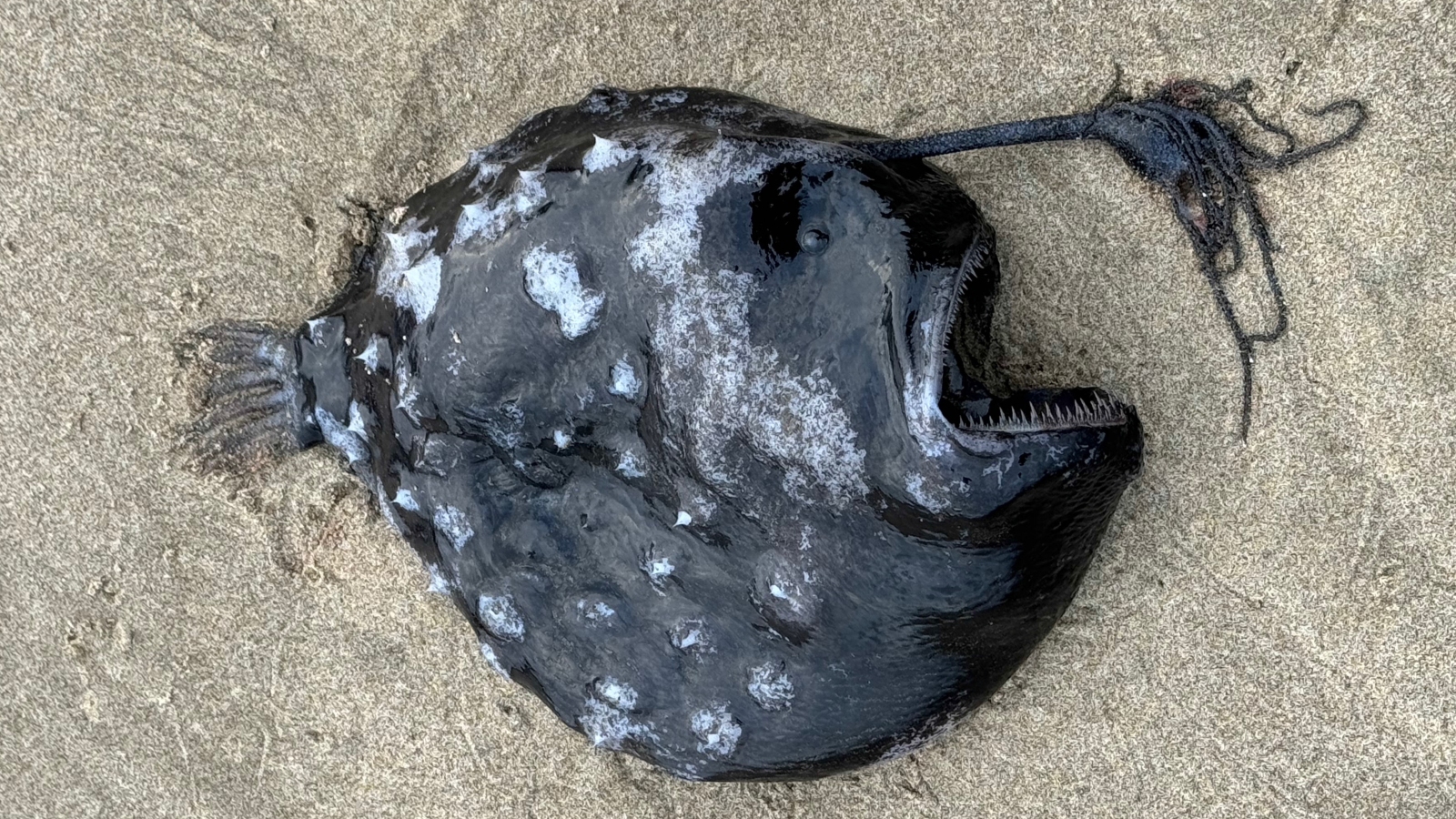Nightmarish 'footballfish' washes up dead on US beach in potential 1st-of-its-kind occurrence
A female Pacific footballfish was found dead on an Oregon beach — potentially for the first time ever. It is currently unclear what killed the alien-looking creature and how it was dragged up from the depths.

An extremely rare, deep-sea "footballfish" recently washed up dead on a beach in Oregon — potentially for the first time in the state's history. It is unclear what killed the creepy-looking creature or how it ended up there.
The nightmarish Pacific footballfish (Himantolophus sagamius) is a species of anglerfish (Lophiiformes) — an order of more than 300 species of deep-sea fish that lurk in the darkness and lure prey toward their fanged jaws with bioluminescent headpieces. Footballfish can live in waters as deep as 3,300 feet (1,000 meters) below the surface and likely dwell in the depths across the Pacific Ocean, although their exact range is unknown.
Beachcombers spotted the lifeless, alien-looking fish on the shoreline south of Cannon Beach earlier this month, according to a May 19 Facebook post from the Seaside Aquarium. It is unclear whether researchers collected and studied the remains after they were photographed by aquarium staff, which could shed light on the creature's mysterious fate.
Pacific footballfish are exceptionally rare. Since the first-ever specimen was accidentally collected in 1975 during a deep-sea trawl in Hawaii, only around 30 individuals have ever been found washed ashore or in the wild, according to the Natural History Museum of Los Angeles County.
"While a handful of football fish have been recorded in New Zealand, Japan, Russia, Hawaii, Ecuador, Chile, and California this is the first one reported on the Oregon Coast to our knowledge," Seaside Aquarium representatives wrote.
Before this recent case, the most recent Pacific footballfish specimen collected in the U.S. was a female found on a beach in Crystal Cove State Park, California, in October 2023. Interestingly, another female was found on the same beach in May 2021, although scientists don't know why both specimens washed up in the same place.
Related: 10 creatures that washed up on the world's beaches in 2023
Get the world’s most fascinating discoveries delivered straight to your inbox.

Like most other anglerfish, footballfish lures are modified segments of the fish's dorsal fin and house bioluminescent bacteria that produce light in exchange for protection and nutrients. But unlike most other anglerfish, which have a single bulb-like lure, Pacific footballfish have segmented lures with multiple tendrils extending from the end of their head stalks.
Previous research revealed that footballfish lures are biofluorescent, meaning they can absorb and reflect light, as well as produce it. This has not been observed in other anglerfish species so far, and researchers think it may enable the footballfish to produce more complex and enticing light shows than other anglerfish.
Footballfish use their lures to attract prey toward their mouths, close enough for the unseen predators to suck them into their gullets in one quick strike. Rows of spiky teeth line the mouths of these predators and point inward to stop the startled prey from escaping their grim fate, according to the California Academy of Sciences.
Like other anglerfish, female Pacific footballfish are much bigger than the males — a phenomenon known as sexual dimorphism. The females, like the one that washed up in Oregon, can grow to around 2 feet (0.6 meter) long, while males only get to around 10% of this size.
This stark size difference is the result of an evolutional oddity known as sexual parasitism. The males act like parasites and spend their whole lives searching for a female host, then latch onto the first one they find — and stay there forever. The males eventually fuse completely to the females and transform into mini sperm factories that fertilize her eggs.
"How the males find the females in the pitch dark is still unknown," Seaside Aquarium representatives wrote. But it was likely a key factor in anglerfish evolving to thrive in the deep sea.

Harry is a U.K.-based senior staff writer at Live Science. He studied marine biology at the University of Exeter before training to become a journalist. He covers a wide range of topics including space exploration, planetary science, space weather, climate change, animal behavior and paleontology. His recent work on the solar maximum won "best space submission" at the 2024 Aerospace Media Awards and was shortlisted in the "top scoop" category at the NCTJ Awards for Excellence in 2023. He also writes Live Science's weekly Earth from space series.


